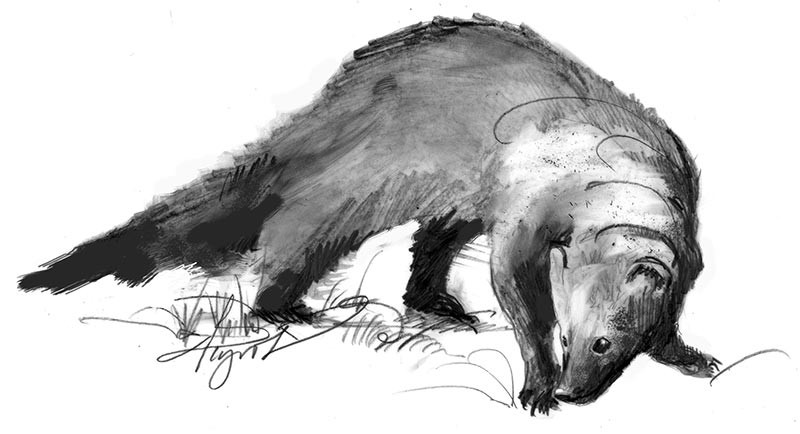
The “fisher cat” is neither of those things. Doesn’t fish. Isn’t a cat. In fact, a lot more of what people think they know about the fisher is wrong. It’s almost like we made up the animal.
The fisher, Pekania pennanti, is a big forest-dwelling weasel, related to the American marten, and native to North America. The common name has nothing to do with fish, but instead derives from French and Dutch words for the pelt of a European polecat, to which it is distantly related. Native American tribes had their own names for the animal, many of which translate roughly as “big marten.”
Then there’s the idea that the fisher is exclusively a denizen of the Northern Forest, the vast realm of spruce and fir. Not true either. “They live in the suburbs of Boston,” said Susan Morse, a wildlife ecologist, forester, and executive director of the nonprofit Keeping Track.
Their range used to be even more extensive. Fishers once lived through New England down the Appalachian Mountains to North Carolina, through the Ohio Valley and across the upper Midwest and north to the tree line, explained Steve Faccio, a conservation biologist at the Vermont Center for Ecostudies.
But the deep woods of the East were rapidly cleared for farming and the big weasel was heavily trapped for its luxuriant fur. By the late 1800s, the fisher “had been extirpated in most of the Northeast outside of Maine and perhaps northernmost New Hampshire,” said Faccio.
Now the fisher is on its way back. “They’ve returned to much of their former range outside of the southern Appalachians,” Faccio said. “In New England they’re doing very well.”
As a graduate student at Southern Connecticut State University in the late 1980s, Faccio helped reintroduce fishers to northeastern Connecticut and radio-tracked them to monitor how well they did. Quite well, it turned out. A couple of dozen fishers were released — half pregnant females, the rest males. A few got hit on the roads, and some decamped for Massachusetts, but most stayed put. And reproduced. Today the population is well established, and Connecticut has a fisher trapping season.
Vermont had a similar reintroduction program, said Faccio, which was partly prompted by the desire to control porcupine numbers. Fishers are one of the few predators that will eat the thorny little beast. They attack its face, then flip it on its back to tear open the unprotected belly.
The fisher owes its resurgence partly to the fact that it’s an omnivore. Like bears. Or humans.
“They will feed on anything, from fruit — apples, blackberries, blueberries — to reptiles and amphibians and birds and bird eggs, up to animals the size of porkies,” said Faccio. During his radio tracking work, Faccio found that they took advantage of the abundant gray squirrels of the oak and hickory forests of northeastern Connecticut. “When we would hike in to check on resting fishers, eight out of ten times we would find the tail of a gray squirrel under the tree and the fisher would be sleeping in the squirrel’s nest up in the canopy.”
Fishers can also move. Really move. “They have the ability to disperse pretty long distances in a short time. They have a kind of energy efficient lope. It seems they can lope forever without stopping, unless the snow is deep and powdery,” he said.
Fishers are secretive and avoid humans. They stay in the forest and don’t like to cross open land. In winter, Faccio can find fisher tracks within five minutes of leaving his door. But he has rarely seen the animals.
One other myth about fishers is that they’re partial to house cats. Eating them, that is. In some studies house cat fur has been found in fisher scat. “But there’s probably a lot easier prey for them to deal with,” Faccio said. If Fluffy vanishes, it’s more likely he got taken out by a Toyota than a fisher.
Then there is the screaming. Fishers are famous for screaming. Or, at least famous for being said to scream. “I don’t know of any reputable information that fishers scream. When we had them in captivity they growled or made purring sounds,” said Faccio.
Even if he sees them only rarely, Faccio is grateful for the big weasel’s presence. “I just like knowing they’re out there. It’s another indication that our ecosystems are functioning. Plus I enjoy getting out and following their tracks. You can feel their energy as they go from brush piles to a fallen tree, or lope over to investigate a hollow tree and then go straight to a spot where there are sometimes porkies. It’s always a fun adventure.”


Discussion *